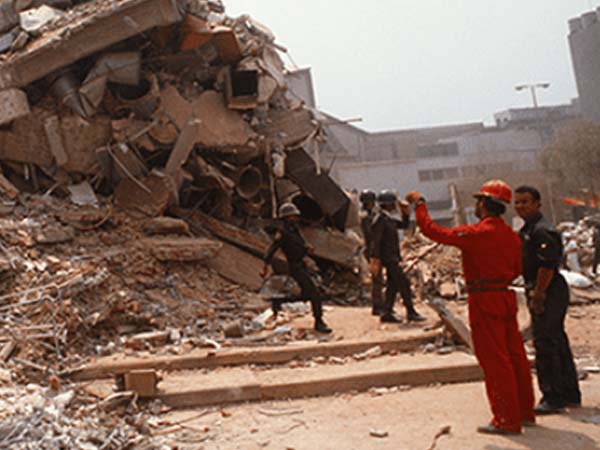Impact of Rise in Sea Level in Mumbai
Wednesday, February 23, 2022 1:00 pm EST
Subscribe to the ThinkND podcast on Apple, Spotify, or Google.
Featured Speakers:
- Dhiraj Mehra, Inaugural Director for Initiatives in India, University of Notre Dame’s Mumbai Global Center
- Krupali Uplekar Krusche, Associate Dean for Research, Scholarship, and Creative Work and Director of DHARMA (Digital Historic Architectural Research and Material Analysis)
The third virtual event of Global Dialogues: The Worsening Water Crisis was moderated by Dhiraj Mehra, Academic Director for Initiatives at Notre Dame International (NDI) Mumbai, India and featured special guest Krupali Uplekar Krusche, Associate Dean at the School of Architecture and Director of DHARMA. The goal of this session was to expand on these professors’ current research and its three main domains: 1) the effect of sea level rise on human activity in Mumbai, 2) the mitigation or “reversal” of sea level rise and how it can be realistically countered, and 3) the future of engineering solutions in preventative measures.
The event consisted of a free-flowing discussion and Q+A session with Director Mehra and Professor Krusche. He began by laying out the dire struggles faced by citizens in Mumbai due to sea level rise and global warming, issues that are quite interconnected at the heart of the matter. Director Mehra opened the floor to Professor Krusche by asking her to describe sea level rise and how it is affecting citizens in Mumbai. Krusche explained that sea level rise comes as a result of glacial melts and temperatures rising, which specifically threatens low-lying cities. Professor Krusche works in digital documentation of cities, and she was able to use her skills to help figure out what would be the most beneficial way for cities to develop in the future when they are confronted by these types of issues. With specific vulnerabilities affecting the daily lives of citizens, this put Mumbai at the forefront for sea level rise research. Director Mehra further asked Professor Krusche to elaborate on what made Mumbai so distinct in terms of sea level rise. Krusche stated that the combined impact of monsoons and sea level rise is creating increased havoc on the infrastructure of the city. Even though this is a disastrous combination, there was little research previously being conducted in this area.
Professor Krushe goes on to discuss how the levels of greenhouse gasses and CO2 emissions will impact how long it will take for sea level rise to seriously impact Mumbai. She discusses the difficulties in data collection for regions using aerial methods, due to foliage and other factors that impact the collection and may cause inaccurate data sets. Director Mehra directed Professor Krusche to talk more about how human activity will be complicated by sea level rise. Krusche discusses how lots of Mumbai is built on top of historic landfills, which therefore causes issues during sea level rises. In addition, fishermen live on the coast and have their livelihoods closely connected to the ocean and its health. It is impossible for these individuals to retreat away from the coast because population density throughout the city is quite high everywhere already.
Director Mehra adds that a lot of the responses to sea level rise are known as climate change mitigation and asks Professor Krusche to speak on this topic with relation to her own work. Mitigation would be finding ways to make sure sea level does not reach certain heights. If the water does reach to those levels then there needs to be certain efforts already in place in those areas to offset the effects of the sea level rise. Adaptation would require individuals to leave the areas that are affected by sea level rise and find new and more development-available areas.
Looking to a larger scale, Director Mehra poses the thought of whether climate change, with respect to sea level rise, can truly be reversed. Professor Krusche states that reversal is an extreme stance at this point in time, but that individuals can work to find sustainable solutions. There needs to be a balance between the built environment and the natural environment. This requires that cities be designed in a way that allows collaboration between infrastructure and nature. Her final thoughts are that humanity needs to first stop the effects of climate change and then move on to finding avenues to reverse climate change.
The discussion moved on to how interdisciplinary research projects and symposiums affect the knowledge on climate change. Professor Krusche hopes that these projections will reach average citizens to inform them on how dire these effects will be on their lives. Some cities have implemented active plans based on these projects to develop cities in a way that mitigates their risks associated with sea level rise. Moving on, Director Mehra asked Professor Krusche how policies need to be changed to respond to climate change. She proposes integrated planning as a way to take research and implement their work into solution-based policies. Furthermore, Professor Krusche explains how her work has developed over time and with what supports it has flourished. Finally, Director Mehra asks how individuals can have a role in stopping climate change. Professor Krusche responds that community members need to strive to reduce the green footprint of the cities and reduce non-recyclable production.
Director Mehra and the panel of Professor Krusche finished the event with questions from the audience, including questions surrounding sea level rise and availability of water supply, how migration fits into the mitigation and adaptation responses, and city design structures and how people naturally tend to situate themselves within cities.
- “With Mumbai being highlighted as one of the large coastal cities that will be affected by this rise in sea level (Mehra, 2:40)
- “You are not just looking at how to do scientific research regarding the sea level, but also come up with comprehensive solutions related to it. Combining the two was a ga I saw in the work that was happening.” (Krusche, 9:00)
- “One of the things we are looking at is, how does the whole city of Mumbai behave, how do specific areas that are planned for future development, how are they going to behave.” (Krusche,12:13)
- “The vulnerability [to sea level rise] exists for everybody that is living in the city in so many ways because this is a very tight city.” (Krusche, 20:25)
- “Something that we are examining as a part of the work we are doing is to see how the built environment actually balances the natural environment. Natural environment is not something that needs to go away, just because the built environment is coming in.” (Krusche, 25:30)
- “Forest land is absolutely diverse with a great ecosystem attached to it, whereas cultivated land, agricultural generally, does not offer the kind of ecosystem to survive in the same way that forest lands would.” (Krusche, 26:06)
- “That we actually design them [cities] in a manner that they are having a good relationship with green spaces within the framework of the city itself. That these are actually interconnected, that allow humans to feel great, but also allow that biodiversity to exist.” (Krusche, 28:00)
- “All other agencies are coming together to say let’s have a comprehensive way in which we are mapping this information [sea level rise data]” (Krusche, 30:48)
- “There is more and more a call that we create a coherent policy across all nations, rather than each one thinking of what they need to do for their own borders because climate change is not really going to work based on your individual policy, but on what is happening around you as well.” (Mehra, 32:28)
- “If we do things the right way, they actually impact for the betterment of society in general and not just one element or just one subset of people, but moreover everybody together.” (Krusche, 39:15)
- “The more these natural resources [drinkable water] leave the location, the more difficult it becomes for people to survive in that area. And then migration is the only option that remains.” (Krusche, 52:48)
Related Content
Shannon Sharpe/Katt Williams, The Black Impact on the NFL Super Bowl & Taraji P Henson
In the first episode for Season 8, Isaiah and Tykiera talk about the Shannon Sharpe/Katt Williams Interview that took the internet by storm at the beginning of the year as well as...
watch videoEveryday Holiness: John Cavadini
Dr. John Cavadini, director of the McGrath Institute for Church Life and professor in the theology department at the University of Notre Dame, shares some of the hidden aspects...
View EventClimate Change and The Limits of Narrative
Join the Kellogg Institute for the introductory session of a workshop refining Kellogg Faculty Fellow Roy Scranton’s draft book project “Ethical Pessimism: Climate Change and...
View Event


